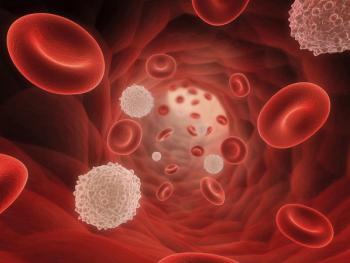
- ONCOLOGY Vol 16 No 3
- Volume 16
- Issue 3
Update of Results of the Combination of Fludarabine, Cyclophosphamide, and Rituximab for Previously Treated Patients With Chronic Lymphocytic Leukemia
In this report, we present our results of the biochemotherapy combination of rituximab (Rituxan), a monoclonal antibody against CD20, with fludarabine (Fludara) and cyclophosphamide (Cytoxan, Neosar).
In this report, we present our results of the biochemotherapy combination ofrituximab (Rituxan), a monoclonal antibody against CD20, with fludarabine (Fludara) and cyclophosphamide(Cytoxan, Neosar). During course 1, rituximab is given at a slow rate at 375mg/m² on day 1 followed by fludarabine at 25 mg/m² and cyclophosphamide at 250mg/m² on days 2-4. During subsequent courses (2-6), rituximab is given at500 mg/m² on day 1 and fludarabine and cyclophosphamide are given at the samedoses but on days 1-3. From November 1999 to July 2001, 167 patients wereregistered, and 102 patients are currently evaluable after more than 6 months offollow-up.
Patient characteristics are as follows: median age, 59 years (range: 36-81years); males, 72.5%; Rai stage IV, 42%; median platelet count, 117 × 109cells/L (range: 15-367 × 109 cells/L); median hemoglobin, 12.1 g/dL (range:6.8-16.5 g/dL); median white blood cell count, 52 × 109 cells/L (range: 1.3-584× 109 cells/L); three or more lymph node sites involved, 59%;beta-2-microglobulin greater than 3 mg/dL, 83%; performance status of ≤ 1, 79%.The median number of prior treatments was 2: 14.7% of the patients had receivedalkylating agents only, 58.8% had been sensitive to fludarabine-containingregimens, and 26.4% had been resistant to fludarabine.
The median follow-up time is 13+ months. Using National Cancer Institutecriteria, the complete response (CR) rate is 23%; nodular partial response, 14%;partial response, 36%; and no response, 20.9%. The total response rate was72.2%. Of 13 patients (38%) in CR, five had immunoglobulin rearrangementsundetectable by polymerase chain reaction. Responses based on prior therapy aresummarized as follows:
Frequent toxicities related to rituximab included chills and fever. Othertoxicities included nausea/vomiting, hypotension, and dyspnea. Serioustoxicities from the treatment included eight episodes of pneumonia, sevenepisodes of neutropenic fever, five of sepsis, and one prolongedmyelosuppression. A total of 26 patients have died.
CONCLUSION: The combination of fludarabine, cyclophosphamide, and rituximabis a very active program for patients with previously treated CLL.
Articles in this issue
almost 24 years ago
Single-Agent Rituximab in Early-Stage Chronic Lymphocytic Leukemiaalmost 24 years ago
Recruitment for Trial of Adjuvant Trastuzumab Under Wayalmost 24 years ago
Rituximab in the Treatment of Acquired Factor VIII Inhibitorsalmost 24 years ago
Support for New Medicare Pay Formulaalmost 24 years ago
Irinotecan-Containing Regimen Improves Survival in Small-Cell Lung CancerNewsletter
Stay up to date on recent advances in the multidisciplinary approach to cancer.

















































































